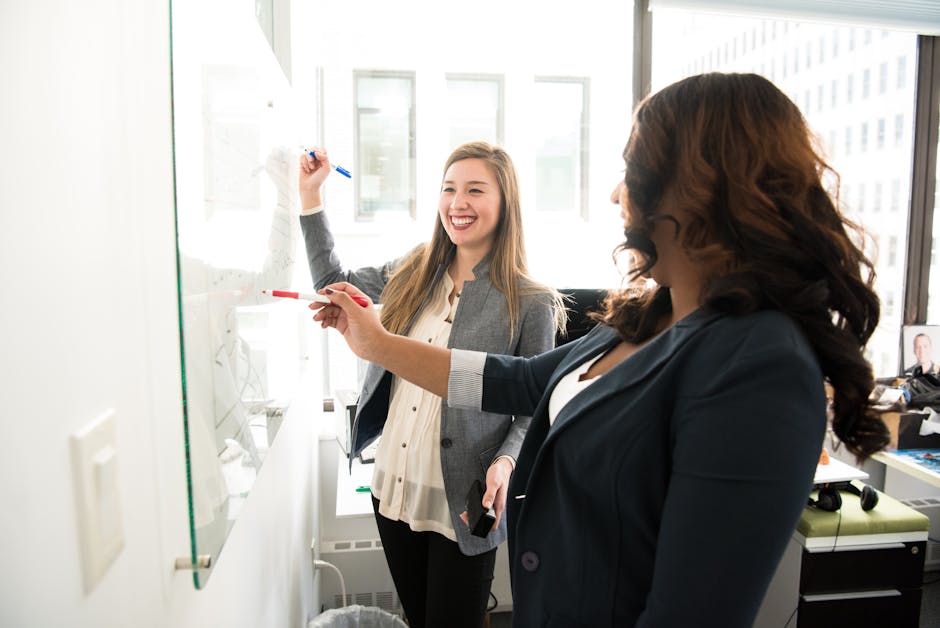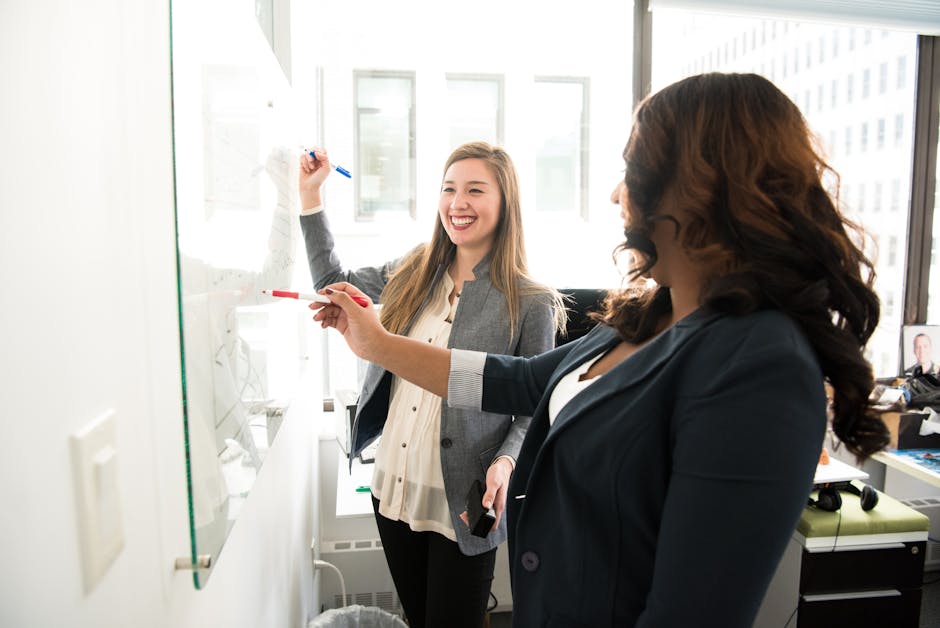Table of Contents
“Innovating spaces for tomorrow’s success.”
Introduction
Designing the workplace of the future is a crucial task that requires careful consideration of various factors such as technology, employee needs, and organizational goals. By creating a workspace that is flexible, inclusive, and innovative, companies can ensure that their employees are productive, engaged, and satisfied. In this article, we will explore some key principles and strategies for designing the workplace of the future.
Flexible Workspaces
In today’s rapidly changing work environment, the concept of a traditional office space is becoming increasingly outdated. With advancements in technology and a shift towards more flexible work arrangements, companies are rethinking the way they design their workspaces. Flexible workspaces have emerged as a popular solution to accommodate the evolving needs of employees and promote collaboration and creativity in the workplace.
One of the key benefits of flexible workspaces is the ability to adapt to the changing needs of employees. With more people working remotely or on flexible schedules, traditional office layouts with assigned desks and cubicles are no longer practical. Flexible workspaces allow employees to choose where and how they work, whether it’s at a desk, in a lounge area, or even outside the office. This flexibility not only increases employee satisfaction but also promotes a more dynamic and collaborative work environment.
Another advantage of flexible workspaces is the ability to optimize space utilization. With traditional office layouts, a significant amount of space is often underutilized due to assigned desks and empty meeting rooms. Flexible workspaces, on the other hand, allow companies to make better use of their space by creating multi-functional areas that can be easily reconfigured to accommodate different activities. This not only saves on real estate costs but also promotes a more efficient use of resources.
In addition to improving space utilization, flexible workspaces can also enhance employee well-being. By providing a variety of work settings, employees have the freedom to choose an environment that best suits their needs, whether it’s a quiet space for focused work or a collaborative area for brainstorming sessions. This flexibility can help reduce stress and increase productivity, as employees are able to work in a way that is most comfortable and conducive to their work style.
Furthermore, flexible workspaces can foster a sense of community and collaboration among employees. By creating open and inviting spaces that encourage interaction and communication, companies can break down silos and promote a culture of teamwork and innovation. This can lead to increased creativity, better problem-solving, and ultimately, improved business outcomes.
To successfully design a flexible workspace, companies must consider a variety of factors, including the needs and preferences of their employees, the nature of their work, and the overall company culture. It’s important to involve employees in the design process to ensure that the workspace meets their needs and supports their work style. Companies should also consider incorporating elements such as natural light, greenery, and ergonomic furniture to create a comfortable and inspiring work environment.
In conclusion, flexible workspaces are a key component of the workplace of the future. By providing employees with the freedom to choose where and how they work, companies can create a more dynamic, efficient, and collaborative work environment. Flexible workspaces not only benefit employees by promoting well-being and productivity but also help companies optimize space utilization and foster a culture of innovation. As companies continue to adapt to the changing needs of the workforce, flexible workspaces will play an increasingly important role in shaping the future of work.
Technology Integration
In today’s rapidly evolving business landscape, the workplace of the future is being shaped by technology integration. As organizations strive to stay competitive and meet the demands of a digital world, they are increasingly turning to technology to enhance productivity, collaboration, and innovation in the workplace.
One of the key trends in workplace design is the integration of smart technology. Smart technology encompasses a wide range of tools and systems that can automate tasks, improve communication, and enhance the overall work environment. For example, smart lighting systems can adjust brightness and color temperature based on natural light levels and employee preferences, creating a more comfortable and productive workspace. Similarly, smart sensors can monitor air quality, temperature, and noise levels, providing valuable data that can be used to optimize the work environment for employee well-being and performance.
Another important aspect of technology integration in the workplace is the adoption of collaborative tools and platforms. With the rise of remote work and distributed teams, organizations are increasingly relying on digital collaboration tools to facilitate communication and teamwork. Platforms like Slack, Microsoft Teams, and Zoom enable employees to connect and collaborate in real-time, regardless of their physical location. These tools not only improve communication and productivity but also foster a sense of community and belonging among remote workers.
Furthermore, the integration of artificial intelligence (AI) and machine learning technologies is revolutionizing the way work is done in the modern workplace. AI-powered tools can automate repetitive tasks, analyze data to uncover insights, and even assist with decision-making processes. For example, AI chatbots can handle customer inquiries, freeing up human employees to focus on more complex and strategic tasks. Machine learning algorithms can also be used to predict trends, identify patterns, and optimize processes, leading to greater efficiency and innovation in the workplace.
As organizations embrace technology integration in the workplace, they must also consider the impact on employee experience and well-being. While technology can enhance productivity and collaboration, it can also lead to feelings of isolation, burnout, and information overload if not implemented thoughtfully. To mitigate these risks, organizations should prioritize employee well-being and create a work environment that supports mental health, work-life balance, and human connection.
In conclusion, designing the workplace of the future requires a strategic approach to technology integration. By leveraging smart technology, collaborative tools, and AI-powered solutions, organizations can create a more efficient, productive, and innovative work environment. However, it is essential to prioritize employee well-being and ensure that technology is used to enhance, rather than replace, human connection and creativity in the workplace. As technology continues to evolve, organizations must adapt and evolve their workplace design to meet the changing needs of employees and the demands of a digital world.
Sustainability Initiatives
In recent years, there has been a growing emphasis on sustainability in the workplace. Companies are recognizing the importance of reducing their environmental impact and are implementing various initiatives to achieve this goal. From energy-efficient lighting to recycling programs, there are many ways in which businesses can make their operations more sustainable.
One key aspect of designing the workplace of the future is incorporating sustainable practices into the office design. This can include using eco-friendly materials in construction, installing energy-efficient appliances, and implementing waste reduction strategies. By making these changes, companies can not only reduce their carbon footprint but also save money in the long run.
One of the most effective ways to promote sustainability in the workplace is through the use of renewable energy sources. Solar panels, wind turbines, and geothermal systems are all viable options for powering office buildings. By generating their own electricity, companies can reduce their reliance on fossil fuels and decrease their overall energy consumption.
Another important aspect of sustainability in the workplace is waste management. Companies can implement recycling programs, composting initiatives, and electronic waste disposal strategies to reduce the amount of waste they produce. By diverting materials from landfills and incinerators, businesses can minimize their environmental impact and contribute to a more sustainable future.
In addition to environmental benefits, sustainability initiatives in the workplace can also have positive social and economic impacts. By promoting a culture of sustainability, companies can attract and retain top talent who are passionate about environmental issues. Employees are more likely to be engaged and productive when they feel that their company is committed to making a positive impact on the world.
Furthermore, implementing sustainability initiatives can help companies save money in the long run. By reducing energy consumption, waste generation, and water usage, businesses can lower their operating costs and increase their bottom line. Sustainable practices can also lead to improved brand reputation and increased customer loyalty, as consumers are increasingly looking to support companies that prioritize environmental responsibility.
Overall, designing the workplace of the future requires a holistic approach that considers the environmental, social, and economic impacts of business operations. By incorporating sustainability initiatives into office design, companies can create a more efficient, productive, and environmentally friendly work environment. From renewable energy sources to waste management strategies, there are many ways in which businesses can promote sustainability in the workplace and contribute to a more sustainable future for all.
Employee Well-being

In recent years, there has been a growing emphasis on the importance of employee well-being in the workplace. Employers are recognizing that happy and healthy employees are more productive, engaged, and loyal. As a result, companies are investing in creating work environments that prioritize the well-being of their employees. Designing the workplace of the future involves considering various factors that contribute to employee well-being.
One key aspect of designing a workplace that promotes employee well-being is creating a physical environment that is conducive to health and wellness. This includes providing ergonomic furniture, natural lighting, and indoor plants to improve air quality. Research has shown that these elements can have a positive impact on employee health and productivity. Additionally, incorporating spaces for physical activity, such as standing desks or on-site fitness facilities, can encourage employees to stay active throughout the workday.
Another important consideration in designing the workplace of the future is fostering a culture of work-life balance. Employers can support employee well-being by offering flexible work arrangements, such as telecommuting or flexible hours, to accommodate personal responsibilities and preferences. Encouraging employees to take breaks and disconnect from work during non-working hours can also help prevent burnout and improve overall well-being.
In addition to physical and cultural factors, technology plays a significant role in shaping the workplace of the future. Employers can leverage technology to support employee well-being by providing tools for remote collaboration, communication, and stress management. For example, mindfulness apps and virtual mental health resources can help employees manage stress and improve their overall well-being. Employers can also use technology to track and analyze employee well-being data to identify trends and areas for improvement.
Furthermore, designing a workplace that promotes employee well-being requires a holistic approach that considers the mental, emotional, and social aspects of well-being. Employers can support mental health by offering employee assistance programs, counseling services, and mental health resources. Creating opportunities for social connection, such as team-building activities and networking events, can also help employees feel connected and supported in the workplace.
Ultimately, designing the workplace of the future is about creating an environment that supports the overall well-being of employees. By prioritizing physical health, work-life balance, technology, and mental and emotional well-being, employers can create a workplace that fosters a positive and productive work environment. Investing in employee well-being not only benefits employees but also contributes to the success and sustainability of the organization as a whole. As we continue to evolve and adapt to the changing needs of the workforce, designing a workplace that prioritizes employee well-being will be essential for attracting and retaining top talent in the future.
Remote Work Policies
Remote work has become increasingly popular in recent years, with more and more companies offering flexible work arrangements to their employees. As technology continues to advance, the traditional office setting is evolving, and employers are rethinking how they design their workplaces to accommodate remote work policies.
One of the key considerations when designing the workplace of the future is creating a space that supports remote work. This means providing employees with the tools and resources they need to work effectively from anywhere. This could include investing in technology such as video conferencing software, cloud-based collaboration tools, and secure VPN connections. By equipping employees with the right technology, companies can ensure that remote workers are able to stay connected and productive.
In addition to technology, companies also need to consider the physical layout of their office space. With more employees working remotely, companies may find that they no longer need as much office space as they once did. This presents an opportunity to rethink how the office is designed, with a focus on creating flexible workspaces that can accommodate both in-person and remote workers. This could include open-plan layouts, hot-desking arrangements, and designated quiet areas for focused work.
Another important aspect of designing the workplace of the future is establishing clear remote work policies. This includes setting expectations around when and where employees are expected to work, as well as outlining guidelines for communication and collaboration. By establishing clear policies, companies can ensure that remote workers are held accountable and that everyone is on the same page.
When designing remote work policies, it’s important to consider the needs of individual employees. Some employees may thrive in a remote work environment, while others may struggle with feelings of isolation or disconnection. Companies can support remote workers by providing opportunities for social interaction, such as virtual team-building activities or regular check-ins with managers. By fostering a sense of community and belonging, companies can help remote workers feel more connected to their colleagues and the organization as a whole.
In addition to social support, companies also need to consider the mental health and well-being of remote workers. Working from home can blur the lines between work and personal life, leading to burnout and stress. Companies can support remote workers by encouraging them to take breaks, setting boundaries around work hours, and providing access to mental health resources. By prioritizing employee well-being, companies can create a more sustainable and productive remote work environment.
In conclusion, designing the workplace of the future requires careful consideration of remote work policies. By investing in technology, creating flexible workspaces, and establishing clear policies, companies can support remote workers and create a more inclusive and productive work environment. By prioritizing the needs of individual employees and fostering a sense of community and well-being, companies can ensure that remote work is a successful and sustainable option for their workforce.
Collaboration Spaces
In today’s fast-paced and ever-evolving work environment, collaboration has become a key component of success for many organizations. As teams become more diverse and dispersed, the need for effective collaboration spaces has never been greater. Designing the workplace of the future requires careful consideration of how to create spaces that foster creativity, communication, and innovation.
One of the key trends in workplace design is the shift towards open and flexible collaboration spaces. These spaces are designed to encourage spontaneous interactions and idea sharing among team members. By breaking down physical barriers and creating a more open and inviting environment, organizations can promote a culture of collaboration and teamwork.
Research has shown that employees are more productive and engaged when they have access to a variety of collaboration spaces. From informal meeting areas to dedicated project rooms, providing employees with a range of options allows them to choose the space that best suits their needs. This flexibility can lead to increased creativity and innovation, as employees are able to work in environments that inspire and motivate them.
Another important consideration when designing collaboration spaces is the use of technology. In today’s digital age, technology plays a crucial role in facilitating communication and collaboration among team members. From video conferencing to virtual whiteboards, incorporating the latest technology into collaboration spaces can help teams work together more effectively, regardless of their physical location.
In addition to technology, the layout and design of collaboration spaces also play a significant role in promoting collaboration. By creating spaces that are comfortable, inviting, and conducive to teamwork, organizations can encourage employees to come together and share ideas. This can lead to increased communication, improved problem-solving, and a stronger sense of camaraderie among team members.
When designing collaboration spaces, it is important to consider the needs and preferences of employees. Some team members may prefer quiet, private spaces for focused work, while others may thrive in more open and social environments. By providing a variety of spaces that cater to different work styles, organizations can create a workplace that is inclusive and accommodating to all employees.
Ultimately, the goal of designing collaboration spaces is to create an environment that fosters creativity, communication, and innovation. By investing in well-designed collaboration spaces, organizations can empower their teams to work together more effectively and achieve greater success. As the workplace continues to evolve, it is essential for organizations to adapt and embrace new ways of working that prioritize collaboration and teamwork. By designing the workplace of the future with collaboration spaces in mind, organizations can create a more dynamic and engaging work environment that inspires creativity and drives innovation.
Biophilic Design
In recent years, there has been a growing emphasis on creating work environments that are not only functional and aesthetically pleasing but also promote employee well-being and productivity. One design trend that has gained popularity in this regard is biophilic design, which seeks to incorporate elements of nature into the built environment. By bringing the outdoors inside, biophilic design aims to create spaces that are more conducive to human health and happiness.
Research has shown that exposure to nature can have a positive impact on our physical and mental well-being. Studies have found that being in natural environments can reduce stress, improve mood, and enhance cognitive function. By incorporating elements such as natural light, plants, and water features into the workplace, biophilic design seeks to harness these benefits and create a more harmonious and productive work environment.
One of the key principles of biophilic design is the idea of creating connections to nature. This can be achieved through the use of materials such as wood and stone, which evoke the natural world, as well as through the incorporation of natural patterns and textures. By bringing these elements into the workplace, designers can help employees feel more connected to the natural world, even when they are indoors.
Another important aspect of biophilic design is the use of natural light. Exposure to natural light has been shown to have a range of benefits, including improved mood, increased productivity, and better sleep. By maximizing the amount of natural light in a space, designers can create a more inviting and energizing work environment. This can be achieved through the use of large windows, skylights, and light wells, as well as through the strategic placement of workstations to take advantage of natural light.
Plants are another key element of biophilic design. Not only do they help to improve air quality and reduce stress, but they also bring a sense of vitality and life to a space. By incorporating plants into the workplace, designers can create a more vibrant and dynamic environment that is conducive to creativity and collaboration. Living walls, vertical gardens, and potted plants can all be used to bring nature into the office and create a more biophilic work environment.
Water features are another important element of biophilic design. The sound of running water has been shown to have a calming effect on the mind, helping to reduce stress and improve focus. By incorporating water features such as fountains, ponds, or even just a small tabletop fountain, designers can create a more tranquil and relaxing work environment. Water features can also help to mask noise and create a sense of privacy in open office spaces.
In conclusion, biophilic design offers a holistic approach to creating work environments that are not only visually appealing but also promote employee well-being and productivity. By incorporating elements of nature such as natural light, plants, and water features into the workplace, designers can create spaces that are more conducive to human health and happiness. As we look to the future of work, biophilic design will continue to play a key role in shaping the workplace of tomorrow.
Inclusive Design
In recent years, there has been a growing emphasis on creating inclusive work environments that cater to the diverse needs of employees. Inclusive design is a concept that focuses on creating spaces that are accessible and welcoming to all individuals, regardless of their age, gender, ability, or background. By incorporating inclusive design principles into the workplace, organizations can foster a more diverse and inclusive culture, improve employee satisfaction and productivity, and attract top talent.
One of the key principles of inclusive design is to consider the needs of all individuals when designing a space. This means taking into account the diverse range of abilities and preferences that employees may have. For example, when designing a workspace, it is important to consider factors such as lighting, acoustics, and furniture layout to ensure that all employees can work comfortably and efficiently. By creating a space that is accessible to everyone, organizations can create a more inclusive and welcoming environment for all employees.
Another important aspect of inclusive design is to involve employees in the design process. By soliciting feedback from employees about their needs and preferences, organizations can ensure that the design of the workspace meets the needs of all individuals. This can help to create a sense of ownership and belonging among employees, as they feel that their voices are being heard and their needs are being taken into consideration.
Inclusive design also involves creating spaces that are flexible and adaptable to the changing needs of employees. This means designing workspaces that can be easily reconfigured to accommodate different work styles and preferences. For example, providing a variety of workstations, such as standing desks, quiet rooms, and collaborative spaces, can allow employees to choose the environment that best suits their needs at any given time. By creating a flexible workspace, organizations can empower employees to work in a way that is most comfortable and productive for them.
Inclusive design also extends beyond the physical workspace to include policies and practices that promote diversity and inclusion. This can include implementing flexible work arrangements, providing accommodations for employees with disabilities, and promoting diversity and inclusion training for all employees. By creating a culture that values diversity and inclusion, organizations can attract and retain top talent from a wide range of backgrounds and experiences.
In conclusion, designing the workplace of the future requires a commitment to inclusive design principles. By creating spaces that are accessible, welcoming, and flexible, organizations can foster a more diverse and inclusive culture, improve employee satisfaction and productivity, and attract top talent. By involving employees in the design process and promoting diversity and inclusion throughout the organization, organizations can create a workplace that is truly inclusive and supportive of all individuals. Inclusive design is not just a trend – it is a fundamental aspect of creating a workplace that is built for the future.
Data-Driven Decision Making
In today’s rapidly evolving business landscape, organizations are constantly seeking ways to stay ahead of the curve and remain competitive. One key aspect that is increasingly being recognized as a critical factor in achieving success is the design of the workplace. As companies strive to attract and retain top talent, create a positive work environment, and foster innovation, the design of the physical workspace plays a crucial role in achieving these goals.
One of the key trends shaping the workplace of the future is data-driven decision making. By leveraging data and analytics, organizations can gain valuable insights into how their employees work, collaborate, and interact with their environment. This data can then be used to inform decisions about workplace design, layout, and amenities, ultimately creating a more productive and engaging work environment.
Data-driven decision making in workplace design involves collecting and analyzing a wide range of data points, including employee feedback, utilization rates of different spaces, and even environmental factors such as lighting and temperature. By gathering this data, organizations can gain a deeper understanding of how their employees work and what factors contribute to their productivity and well-being.
For example, by analyzing data on how employees use different workspaces within the office, organizations can identify trends and patterns that can inform decisions about space allocation and layout. If certain areas of the office are consistently underutilized, this data can indicate a need to reconfigure the space or repurpose it for a different use. Similarly, if employees report feeling uncomfortable in certain areas due to factors such as poor lighting or noise levels, this data can prompt organizations to make changes to improve the overall work environment.
In addition to improving the physical workspace, data-driven decision making can also inform decisions about workplace amenities and perks. By analyzing data on employee preferences and satisfaction levels, organizations can identify which amenities are most valued by their employees and which ones may need to be adjusted or added. For example, if data shows that employees highly value access to natural light and outdoor spaces, organizations may choose to prioritize these features in their workplace design.
Furthermore, data-driven decision making can also help organizations measure the impact of workplace design changes on employee productivity and satisfaction. By tracking key performance indicators before and after implementing changes to the workspace, organizations can assess the effectiveness of their design decisions and make adjustments as needed. This iterative approach to workplace design allows organizations to continuously improve the work environment and create a space that meets the evolving needs of their employees.
Overall, data-driven decision making is a powerful tool for designing the workplace of the future. By leveraging data and analytics, organizations can gain valuable insights into how their employees work and interact with their environment, ultimately creating a more productive, engaging, and innovative work environment. As organizations continue to prioritize employee well-being and satisfaction, data-driven decision making will play an increasingly important role in shaping the workplace of the future.
Q&A
1. What are some key trends in workplace design for the future?
– Flexible workspaces, biophilic design, and technology integration.
2. How can workplace design impact employee productivity?
– By creating a comfortable and inspiring environment that supports collaboration and focus.
3. What role does technology play in the workplace of the future?
– Technology enables remote work, collaboration, and data-driven decision making.
4. How can companies incorporate sustainability into their workplace design?
– By using eco-friendly materials, energy-efficient systems, and promoting recycling and waste reduction.
5. What are some ways to promote employee well-being through workplace design?
– Providing ergonomic furniture, natural lighting, and spaces for relaxation and exercise.
6. How can workplace design support diversity and inclusion?
– By creating spaces that are accessible to all, promoting cultural awareness, and providing opportunities for all employees to contribute.
7. What are some challenges companies may face when designing the workplace of the future?
– Balancing the need for privacy with the desire for collaboration, adapting to changing technology, and addressing the preferences of a diverse workforce.
8. How can companies measure the success of their workplace design initiatives?
– Through employee surveys, productivity metrics, and retention rates.
9. What are some best practices for designing a future-proof workplace?
– Stay flexible, involve employees in the design process, and regularly evaluate and update the workspace to meet changing needs.
Conclusion
In conclusion, designing the workplace of the future will require a focus on flexibility, collaboration, and technology integration to meet the evolving needs of employees and businesses. By creating a space that fosters creativity, innovation, and well-being, organizations can attract and retain top talent while driving productivity and success in the digital age.





